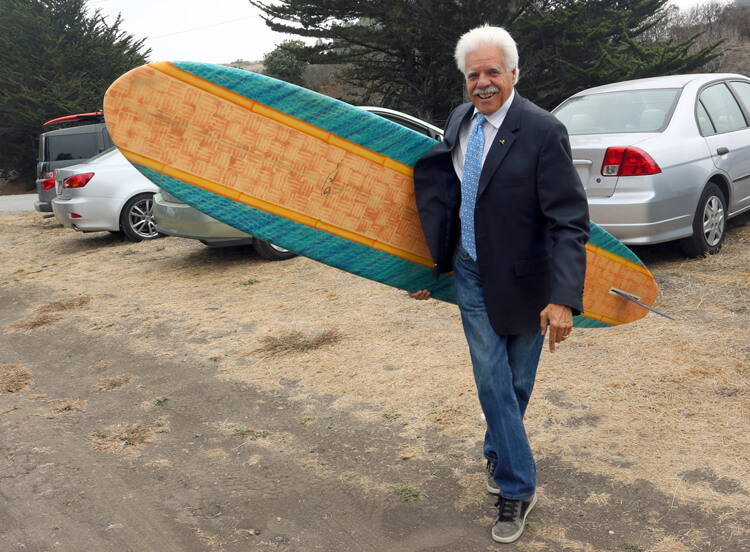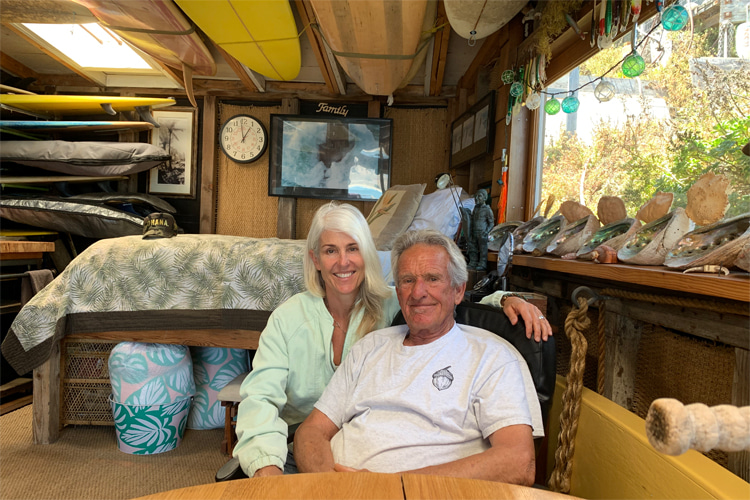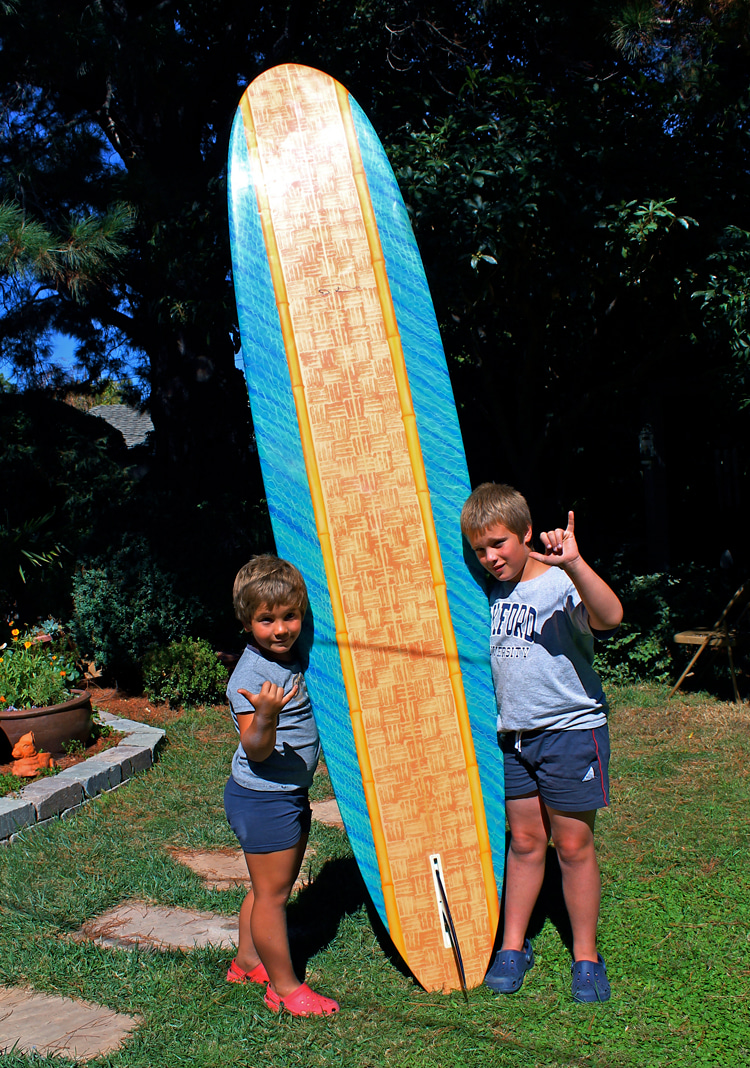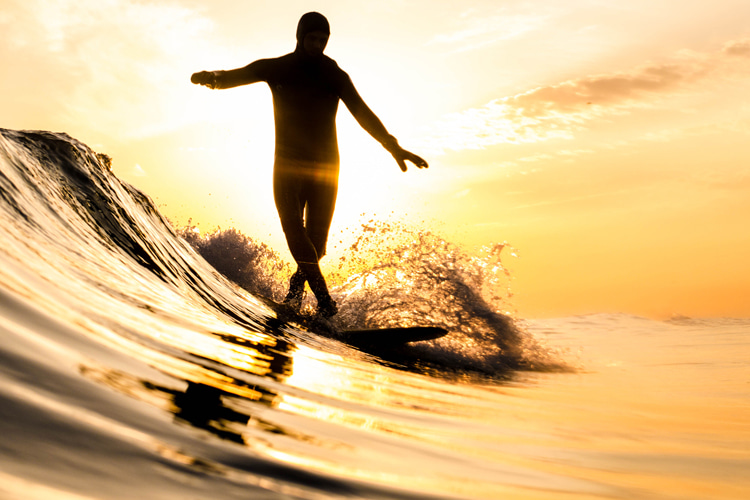If you want to become a better surfer, junk that soulless soft-top, pop out immediately.
Search the beach, and find the best local surfboard builder. It's even better if your best local board builder is also one of your best friends.
Then, pay generously for a custom-designed board that should be made to your specifications. But remember, you may not know what your best specifications are.
For a half-century, my boards were all made by one of the great watermen of my surfing era, Dick Keating.
I've often said that getting a surfboard from Dicky is like getting a violin from Mr. Stradivarius.
I've never given him any instructions.
I've always just said, "You know how I surf and what I like to do. Make me a board I can do it on."
He has never been a big name in the surfboard shaping industry, although O'Neill put out one of his shapes, "The Dick Keating Delight," back in the 1960s.
But among big wave riders, Dicky is a well-respected pioneer. He won the inaugural California Big Wave Contest in 1964.
He tied with Eddie Aikau for ninth in the third Duke Kahanamoku Invitational Surfing Championship.
Fred Van Dyke wrote about the Pacifica-born surfer in the first book, "30 Years of Riding the World's Biggest Waves," and paid him the ultimate tribute by giving him the title of "a true waterman."

The Incredible Floating Man
Dicky gave up surfing in contests so that the rest of us could win one every once in a while.
His is a life of the water. He fishes for a living. His house is on a dock.
He says he has "the world's best commute" as he slides his 14-foot wooden boat down the skids into the ocean.
And, of course, he surfs for fun. Dick Keating started surfing in 1946.
His parents, Leah and Bob Keating, and his uncle Dick, were pioneer surfers in Northern California back in the early 1940s.
One of the family photos is Dicky, at age two, lying happily on a 12-foot hollow surfboard at Pedro Point, where he has always lived.
Pedro Point is a well-known break in the Northern California coastal town of Pacifica.
In addition to surfing, fishing, and diving, Dick sleeps on a waterbed.
For all these reasons, we have long called him the "incredible floating man."
He has likely ridden several hundred thousand waves. He has ridden them all, large and small, with style and grace.
For 60 years, he has been building his own boards. Every few years, he builds two for his daughters and sometimes for a couple of friends.
He does the whole board, not just shaping it. He is too much of a perfectionist to let anyone else do the rest of it.
He uses only top-quality glass.
I started surfing with Dicky in 1960, and I've seen a lot of boards. But the last board he made for me is the most beautiful I have ever seen.
My board is the culmination of Dick's lifetime - in, on, and under the ocean he cherishes.
It is also the result of a "research and development" expedition he took to the (Hawaiian?) islands in the late 1960s.
Keating deliberately rode many different shapes, sizes, and styles of boards.
"I wasn't trying to look good. I was just trying to figure out what each one could do best," Keating revealed.
Once the tests were finished, Dicky incorporated the best features of each one of them and combined them into a unique, exclusive shape.

The Surfboard as Functional Art
The outcome is recognizable when you ride a wave - it's one of the magic surfboards that we only have the chance to experience every once in a while.
The shape is classic. It is a nine-foot-long, 22 inches wide, five-1/4-inch, square tail surfboard with only one fin.
However, the template and shape feature several subtle refinements.
You'll notice a slight concave in the nose for extra lift and stability and an almost imperceptible "V" in the tail.
The hips are high and about six inches above the center. The rails are quite thin, harder in the rear, and softer in the middle.
The board is very light and almost eyeball-controlled in its responsiveness. It will carve easy sweeping turns but has a bit of extra squirt.
The amazing artwork on my board was created by Gary Zerrilla, another Pedro Point surfer who lives on Kauai.
Gary is a skilled carpenter and craftsman.
He did his undergraduate work at the Academy of Art College in San Francisco and earned a Master's Degree in Art from Stanford University.
The board is an amazing canvas for his photorealistic airbrushing art style.
A few years ago, Zerrilla did a board with orange, black, and red-hot lava flowing from the tip to the tail.
It was so hot-looking you could hear it sizzle.
Gary developed a secret technique that can easily make a surfboard look like Koa wood or carved balsa, even to the way the grain changes on the curved rails.
He also makes exquisite banana leaf and bamboo boards.
Zerilla also painted a surfboard with "a liquid look" for supermodel Christy Brinkley, which was as luscious and luminescent as a tropical lagoon.
Although the modest DK logo - with Pedro Point etched in the background - is familiar to veteran surfers from Santa Cruz to San Francisco, and Gary has painted several boards in the islands, neither is well known.
They don't manufacture large quantities of boards for large shops; they are, fittingly, artists.
Surfboards are functional art. Our culture doesn't usually seem to reward true craftsmen and artists with enough recognition and appreciation.

A Precious and Priceless Treasure
But I know that I will always treasure this beautiful hydrodynamic sculpture.
I didn't ride my new board until I had some professional photos taken before I waxed up.
But I already knew exactly how it would feel because I rode the prototype that Dicky made for himself.
I immediately tried to buy it from him, and so did Jim Rhodes and Mike Notmeyer. Every surfer who tried it immediately wanted it.
It was so sweet and responsive that Dick built one for his daughter and then made one for each of us to keep the local peace.
Now, when I wax it, I'll feel like Davy Crockett must have felt when he polished the bronze and silver fittings on "Old Betsy," his ornate flintlock Kentucky long rifle.
I'll know the satisfaction that glinted in Jim Bowie's eye when he put the edge on his famous blade.
I'll feel the passion B.B. King felt when he was stroking "Lucille," his lovely guitar.
Dicky and Gary are local seaside treasures. Many other beaches have their own craftsmen and artists.
They don't do it just for the money - most people could not afford to pay for all their expert knowledge, the extra time, the care, or the pride they put into each custom board.
When Dick makes a board for me, all the decades of our friendship and fun from the many surfing adventures we've shared are built into it.
It's a priceless pleasure that comes with a custom board made by friends who cannot be bought.
A deep love of the sport is part of the reason they make boards.
The satisfaction that comes from creating something truly beautiful must be one of the main psychic benefits.
Local custom board makers, people like Dicky and Gary, are like precious seashells.
To find them, all you have to do is keep your eyes open and spend a lot of time at the seashore. And bring an appreciation for art.
Words by Robert Caughlan | Environmentalist, Surfer, and Author of "A Surfer In The White House"
